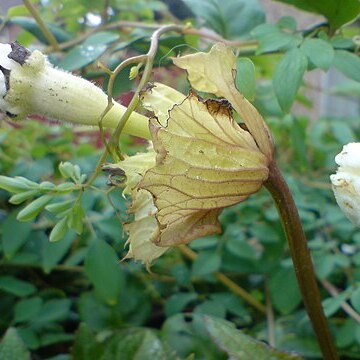Plants to 20-30 m. Stem and branches glabrous. Petiole robust, 4-8 cm, striate, glabrous; leaf blade 15-24 × 15-24 cm, leathery, both surfaces glabrous, 3-5-lobed, mostly 5-lobed; lobes ovate-oblong, base truncate, apex acuminate. Male peduncle thick, 15-30 cm, striate, glabrous or puberulent; bracts oblong-lanceolate, 5-10 mm, fleshy; pedicels short, thick, glabrous or puberulent; calyx tube yellowish, narrowly tubular, 7-10(-12) cm × 7-9 mm, dilated only at very apex; segments triangular-lanceolate, 2-4 mm; corolla yellow outside, white inside; segments ca. 5 cm, fimbriate fringes up to 15 cm. Female pedicels robust, short; ovary subglobose, 2-2.2 cm in diam. Fruit reddish brown, compressed globose, 10-16 × ca. 20 cm, smooth or shallowly grooved. Seeds oblong, ca. 7 × 3 cm, mostly compound. Fl. and fr. Jun-Oct.
More
A large climber. The vines can be 20 m long. The inter-nodes are 10-20 cm long. They are 8-12 cm wide. The tendrils have 2-5 branches. The leaves are oval or heart shaped and have 5 parts like fingers on a hand. The leaves are 15-20 cm across. The lobes are oval and taper to the tip. The leaf stalks are 6-10 cm long and twisted. The flowers are yellowish-white. Male and female flowers are on separate plants. The male flowers are in groups of 2-7 in the axils. The female flowers occur singly. They have 5 lobes and long twisted fringes. The fruit are 12-18 cm long and 20-26 cm across. The are pale red-brown. The skin is thin and firm and the pulp is spongy and juicy. There are 6 seed sacks in a group. They are 7-10 cm long and 5-7 cm wide. There are 1-3 seeds. They are flattened and have wings.

